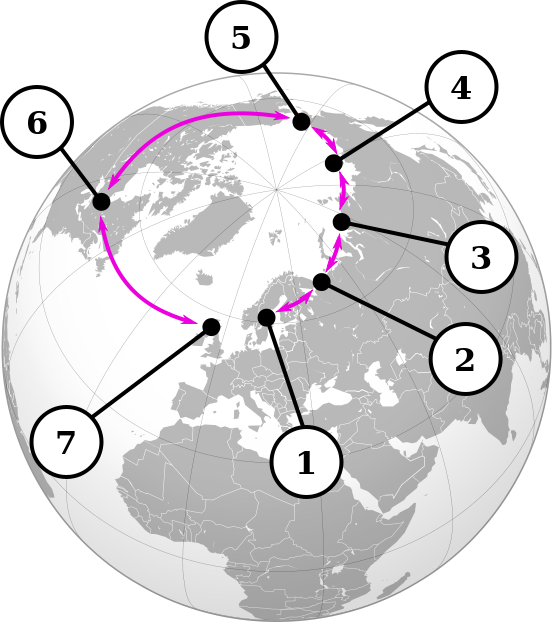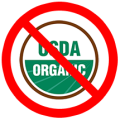Which Came First, the Chicken or the Egg? And a Discussion of the Fuzziness of Species
This entry is part of a collection on Understanding Evolution. For other entries in this collection, follow that link.
 It's a perennial philosophical question, 'Which came first, the chicken or the egg?' Now, thanks to our understanding of evolution, we can give a better answer. But even with science, I've seen many attempts to answer this question that get details wrong. I've written my own answer before in the entry, Which Came First, the Chicken or the Egg?, but after running across this question again on the site, Quora, I've had a few more thoughts on how to better explain it. For this entry, I'll pull from both my Quora answer and my previous blog entry, to try to provide a better answer to this age old question.
It's a perennial philosophical question, 'Which came first, the chicken or the egg?' Now, thanks to our understanding of evolution, we can give a better answer. But even with science, I've seen many attempts to answer this question that get details wrong. I've written my own answer before in the entry, Which Came First, the Chicken or the Egg?, but after running across this question again on the site, Quora, I've had a few more thoughts on how to better explain it. For this entry, I'll pull from both my Quora answer and my previous blog entry, to try to provide a better answer to this age old question.
Just because you can phrase a question a certain way doesn't mean the answer has to follow that form. As an example, think of another question - when does dusk become night? There's no exact answer, because it's a subtle process that changes continuously from light to dark. You can't pinpoint the exact time when it becomes night.
That's how it is with evolution. There are gradually changing populations. If you used a time machine to follow the population that evolved from proto-chickens into true chickens, there's no single individual you could pick out as sufficiently different from its ancestors to call it the first chicken. Even if you tried to set up some arbitrary qualification of requiring certain specific genetic mutations, remember that all of the animals in that population are reproducing sexually. So even if one animal pops up with the genome that fits your criteria of 'chicken', it's going to mate with another animal in that population and scramble up that genome for the next generation. Since that mate didn't fit your criteria for chicken, it's lacking at least one of your required mutations, so at least around half of that pair's offspring is going to revert back to not being chickens. If the mate was lacking several of your 'first' chicken's mutations, then potentially none of their offspring will fit your criteria as being chickens. Does it make sense to define an individual as the first chicken if all of its offspring revert back to not being chickens? Does it make any sense at all to call an animal essentially indistinguishable from its parents as a different type of animal from them? The problem is in trying to apply a precise label to a process that isn't precise.
In reality, species is a very fuzzy concept. The biological species concept is the one most used for sexually reproducing animals. Wikipedia gives a definition for it as follows.
A biological species is a group of individuals which can breed together (panmixia). However, they cannot breed with other groups. In other words, the group is reproductively isolated from other groups.
This idea of reproductive isolation is where the fuzziness comes in -- how much reproductive isolation is necessary to classify two populations as distinct species? For example, horses and donkeys can breed and produce offspring, but those offspring are sterile, so they still get classified as two species. Polar bears and grizzly bears can breed, and their offspring are fertile. But because they don't breed very often, there's very little genetic mixing between their populations, so they do get classified as different species. Dogs and wolves can breed and produce fertile offspring, and there's more mixing than with polar bears and grizzly bears, but little enough that they're still referred to as separate species.
There's a trend here. Reproductive isolation isn't a black and white property. It comes in varying degrees, and that degree depends an awful lot on how long two populations have been separated. It's not like there's a single mutation and Bam! -- no more breeding. The longer two populations are separated, the more unique changes build up in each population, and the more dissimilar their genomes become. If they've only been separated for a very short while and then come back in contact, there won't be any trouble at all with interbreeding. If it's been a bit longer, maybe breeding will result in a few more miscarriages, or a few more infertile offspring, but only a small fraction of all offspring. Longer still, and maybe fertile offspring become the minority. A bit longer, and maybe even infertile offspring would be rare. Even longer still, and maybe all the matings result in miscarriages. And after enough time, mating might not even allow the sperm to fertilize the egg.
In other words, speciation isn't a specific event. It's a process. The longer two populations are separated, the more reproductively isolated they become, shading from a single species to breeds to subspecies to separate species.
There are a few more interesting examples to illustrate the fuzziness of defining species. The first is one I already brought up - mules. In fact, when I wrote up above that horses and donkeys can breed to produce sterile mules, the truth is a little more complicated than that. While there haven't been any known fertile male mules, there have been a few fertile female mules. So, where does that put them with the biological species definition? They're mating does create some, if not many, fertile offspring.
Another interesting case is what's known as a ring species (or perhaps a better term might be pseudo ring species**). These are animals that have a range that encircles some type of barrier. A classic example is the Larus gull, which lives in a band around the Arctic Ocean. If you start with the European Herring Gull which lives mainly in Great Britain, it can mate with the American Herring Gull to the west. And they do this often enough that their gene pools mix, which indicates that they're merely subspecies, not completely different species. And if you go west from there, the American Herring Gull can mate with the East Siberian Herring Gull. And you can keep going west, with the groups being able to interbreed, all the way until you get to Lesser Black-backed Gulls, which live mainly in Europe but which also stray into Great Britain. But guess what, the Lesser Black-backed Gulls in Great Britain don't mate with the European Herring Gulls on the same island. So how do these animals get classified as a species? There's one large interbreeding population right now, which would indicate one species. But what if all of the subspecies were to go extinct except for Lesser Black-backed Gulls and European Herring Gulls? Would they instantly become two new species?

Perhaps a more familiar example is dogs. Everybody knows that dogs can interbreed. That's where muts come from. But what if some super-villain were to come along and kill every breed of dog except for Chihuahuas and great Danes? Now, I know that technically you could probably give them a hand to do the deed and make puppies, and they might even be fertile. But, if left to their own devices, they'd be two pretty effectively isolated breeding populations. (I suspect this page is either a joke or an urban legend, but it still reveals the difficulties that would be involved). So, given the current dog population, chihuahuas and great Danes are part of the same species. But there's no way they would be considered the same species if they were the only dogs left in existence.
Given that species is such a fuzzy concept to begin with, it makes no sense to think of a 'first' of any species. There's no great big event mutating an entire genome that produces a 'hopeful monster'. Speciation is a process, the accumulation of countless small mutations in two separate populations until eventually those two populations have genomes that are incompatible. There's no point where you can pick one organism as being a different species from its parent.
So, the next time you hear someone ask, 'Which came first, the chicken or the egg?', you can explain why the answer is neither. Since you can't precisely define the first chicken, you can't precisely define the first chicken egg, and you certainly can't say which came first.
Image Source: Brain Pickings
*I'm assuming that the question implies it's a chicken egg. It doesn't make much sense to ask which came first, the chicken or the dinosaur egg, because then there's no conundrum at all.
**The example I described isn't exactly the definition of ring species, at least using the classic definition. Per the classic definition, a ring species is one that has gradually encircled some type of barrier, with individuals in different locations facing different selection pressures per their local environments. As the population expands its range around that barrier, it eventually meets back up with the original population, and in a ring species, the differences between the individuals at each end of the range are great enough that they don't interbreed. The classic definition also assumes that the population has remained unbroken throughout its entire history, and that the different genetics between each end occured without any geographic isolation to stop gene flow. However, pretty much every ring species that's been studied shows evidence that there have been periods of geographic isolation in the past, accounting for much of the divergence between populations. However, there are many of these pseudo ring species that still follow the pattern I described up above, where neighboring populations can all interbreed except for those at the start/end of the ring. (more info - Why Evolution Is True)
Updated 2017-03-27: Added diagram of gull range
Want to learn more about evolution? Find more at Understanding Evolution.

 Organic food is becoming increasingly popular. The
Organic food is becoming increasingly popular. The  With July behind me, it's time again to look at the server logs to see what pages on this site were most popular last month. Every page that made it this time had made it some time before, and in fact, most of them made the previous month. So, no surprises.
With July behind me, it's time again to look at the server logs to see what pages on this site were most popular last month. Every page that made it this time had made it some time before, and in fact, most of them made the previous month. So, no surprises.